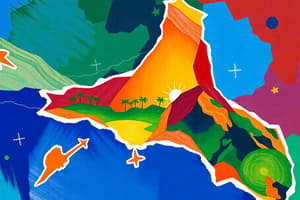Podcast
Questions and Answers
Where did the Kalinga and other Cordillera peoples arrive from?
Where did the Kalinga and other Cordillera peoples arrive from?
Southeastern or eastern Asia
Which ethnolinguistic groups are mentioned in the text? (Select all that apply)
Which ethnolinguistic groups are mentioned in the text? (Select all that apply)
- Bontok (correct)
- Ifugao (correct)
- Cebuano
- Ibaloy (correct)
What type of agricultural practices developed among the mountain peoples?
What type of agricultural practices developed among the mountain peoples?
Swidden farming, wet rice cultivation, irrigated terrace farming
What characterizes the western side of Kalinga?
What characterizes the western side of Kalinga?
What are the total area and size of the province of Kalinga?
What are the total area and size of the province of Kalinga?
Rizal and Tabuk are the biggest rice producers in Kalinga.
Rizal and Tabuk are the biggest rice producers in Kalinga.
What is the historical significance of Lubuagan in Kalinga?
What is the historical significance of Lubuagan in Kalinga?
Which municipality in Kalinga is known for having large volumes of sulfur deposits and hot springs?
Which municipality in Kalinga is known for having large volumes of sulfur deposits and hot springs?
What is the classification of Balbalan municipality?
What is the classification of Balbalan municipality?
Which two municipalities were derived from Balbalan and Lubuagan?
Which two municipalities were derived from Balbalan and Lubuagan?
Who are the predominant populations in Rizal municipality?
Who are the predominant populations in Rizal municipality?
Flashcards are hidden until you start studying
Study Notes
Kalinga Heritage: Settlements and Territories
- The Kalinga province is located in the northernmost section of the Cordillera Region in Luzon, Philippines.
- It is bounded by the provinces of Cagayan and Apayao in the north, Mt. Province in the south, Abra in the west, and Isabela in the east.
- The province has a total area of 3,231.25 square kilometers.
- The terrain of the province is characterized by sharp-crested interlinking mountain peaks, steep slopes, isolated flat lands, plateau, and valleys in the west.
- The eastern section of Kalinga is generally rolling with gradually sloping foothills, interlocking wide tracks of flat lands, and floodplains along its main rivers.
- The province has potential tourism sights including waterfalls, hot springs, rice terraces, and subterranean rivers.
Kalinga Municipalities
- Balbalan: Located in the northwestern portion of Kalinga, bounded by Conner (Apayao) to the north, Pinukpuk to the east, Pasil to the south, and Abra to the west.
- Became a regular municipality in 1963 with 14 barangays and is classified as a fifth-class municipality.
- 99% of the population are native Kalingas.
- Lubuagan: Was once the provincial capital of Kalinga, hosting the first two secondary schools in 1927.
- Became a sixth-class regular municipality in 1963.
- 90% of the population are native Kalingas, with the rest being Ilocanos and Tagalogs.
- It derives its name from the archaic term "Lubuaganon", meaning wallowing place, as the original site of Lubuagan Poblacion was a marshy place.
- Pasil: Created from barangays of Balbalan and Lubuagan in 1966.
- Lies south of Balbalan, west of Upper Tabuk, north of Lubuagan, and east of Abra.
- Notable for large volumes of sulfur deposits and hot springs, as well as an extinct volcano that emits black smoke – a potential tourist spot.
- Pinukpuk: Organized as a municipal district in 1908 and converted into a sixth-class municipality in 1963.
- Bounded by Conner to the north, Tabuk to the south, Balbalan to the west, and Rizal, Kalinga, and Tuao Cagayan to the east.
- Rich soil potential and gentle terrain, with abundant narra trees, rattan, and other forest products.
- Rizal: Created in 1965 from a portion of Tabuk.
- Bounded by Palca, Tuao, and Enrile Cagayan to the north, Sta. Maria, Isabela to the south, and Tabuk to the west.
- Population is a mix of native Kalingas, Bontocs, Benguets, Ibanags, Ilocanos, and Tagalogs.
- Tabuk: Capital town of Kalinga.
- Bounded by Pinukpuk to the north, Rizal and Quezon Isabela to the east, Tanudan and Paracelis to the south, Mt. Province to the south, and Pasil and Balbalan to the west.
- Population consists of native Kalingas, Bontocs, Benguets, Ilokanos, Tagalogs, Ibanags, and other immigrants.
Studying That Suits You
Use AI to generate personalized quizzes and flashcards to suit your learning preferences.




